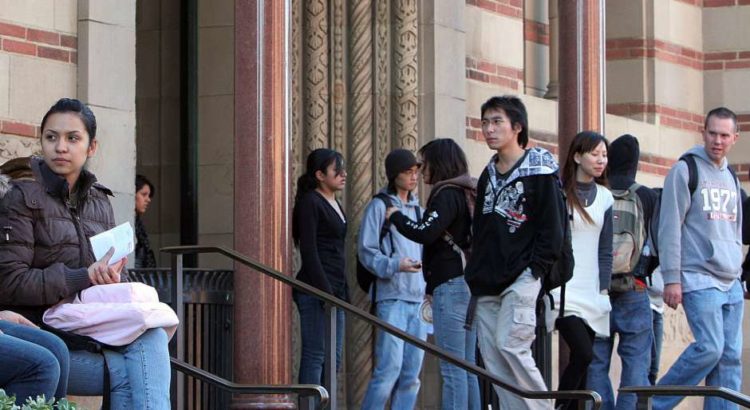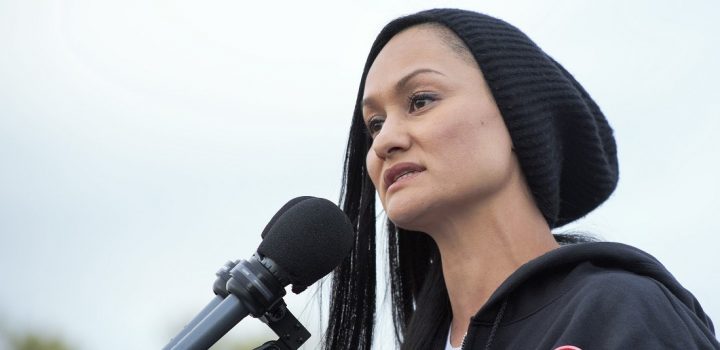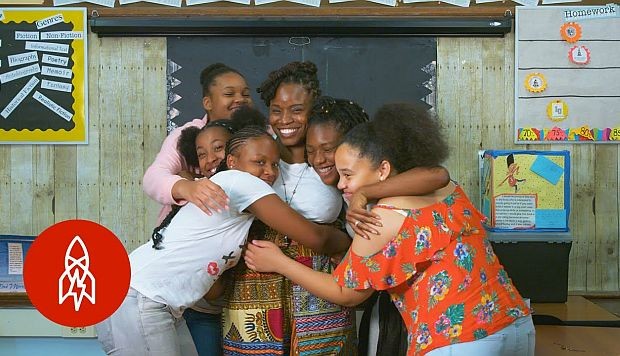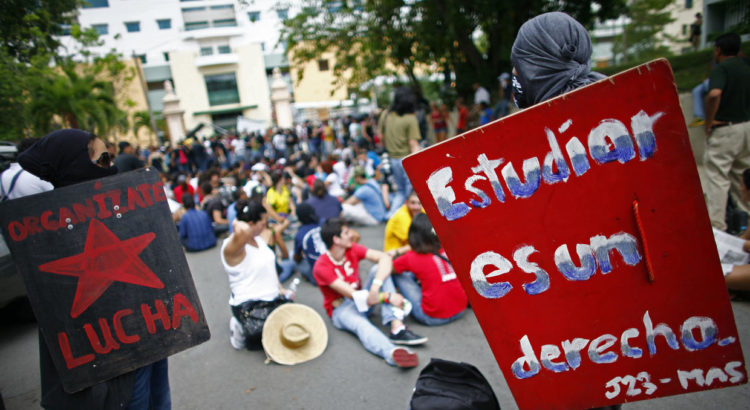Carmen Pérez, directora ejecutiva de Gathering for Justice y co directora de la Marcha de las Mujeres, participó en la mesa de apertura del Global Media Forum, realizado en Bonn. Pressenza aprovechó para hacerle esta entrevista, que compartimos con nuestros lectores.
P: Carmen, el mundo se sorprendió el día que tanta gente y sobre todo tantas mujeres se movilizaron en Estados Unidos. Quizás no se entendió del todo qué fue lo que hizo que esa movilización fuera tan sorprendente, multitudinaria y poderosa. ¿Cuáles fueron los procesos que estuvieron detrás de esa marcha?
CP: Mucho de lo que ustedes vieron se debió a que habíamos intentado hablar con personas y crear un punto de entrada para que la gente empiece a involucrarse. Después de la elección de Trump, nosotros nos sentíamos como si alguien se hubiera muerto en nuestro país. Era un duelo. Sentí una responsabilidad por mi comunidad, como descendiente de mexicanos. Mi mamá es nacida en México, mi papá es nacido en los Estados Unidos. Pero lo que el presidente dijo de mi familia, de nuestros hermanos que son de allá, hizo que me decida a involucrarme en la organización de esta marcha. Nos unimos con Tamika Mallory, afroamericana y Linda Sarsour, palestina-musulmana y decidimos organizarla, hacer la agenda, traer a las personas., sumar a nuestros equipos y a muchas organizaciones.
Yo trabajo en la organización Harry Belafonte, desde la cual buscamos fomentar el compromiso cívico y organizar acciones políticas. Por ello pensamos que teníamos que ser parte de la marcha de las mujeres, centrándonos en musulmanes, LGBTQIA, indocumentados, afroamericanos, derechos de las mujeres, todos estos diferentes grupos, y teniendo como base nuestros principios de la noviolencia.
Teníamos claro que no iba a ser una marcha en contra de Trump, porque uno de los seis principios de la noviolencia es atacar las fuerzas del mal, no a las personas que hacen el mal. Así que, no se trata de Trump, sino de luchar contra las instituciones que empujan el racismo, el sexismo y cualquier tipo de discriminación.
P: Tú has mencionado varias veces la importancia de poner la agenda. ¿cuál es la agenda que pusieron en esa marcha y por la que ahora están trabajando?
CP: Nosotras creamos una plataforma en la que todos se sintieran incluidos. Fue un proceso transparente y muy participativo. Esa plataforma incluye 14 puntos relacionados con género, medio ambiente, justicia criminal, derechos indígenas, comunidades LGBTQIA. Es una plataforma política interseccional. Nuestra agenda no es únicamente de mujeres, porque como mujeres, somos interseccionales también: yo soy hija de una madre mexicana nacida en California, que creció con violencia en su comunidad, estudié psicología… No somos monolíticas. La plataforma que generamos es, sin duda, una de las más radicales plataformas políticas en la historia de los Estados Unidos.
El 21 de enero estuvimos 1.2 millones de personas, aunque el permiso que nos dieron (y solamente a nosotras nos exigieron contar con un permiso para organizar la movilización), era solamente para 200 mil. Queríamos que se movilizara mucha gente de color, que marchan también los inmigrantes e indocumentados. Eran 70 organizadoras a nivel nacional, 400 coordinadoras. Esta marcha se hizo con la participación de gente de todo el mundo, con mujeres que eran voluntarias, nadie recibió un cheque para organizar esta marcha. Había cinco millones de personas participando en todo el mundo y ningún incidente violento. Ese es el poder que nosotros vemos cuando la gente, cuando las mujeres se unen para hacer algo grande.
P: Has mencionado varias veces los seis principios de la noviolencia. ¿Cuáles son esos seis principios?
CP: No los tengo todos de memoria. Hay uno que dice, “Accept suffering without retaliation for the sake of the cause to achieve our goal” (Acepta el sufrimiento sin represalias por el bien de la causa, para alcanzar nuestro objetivo). Otro principio dice, “The Universe is on the side of justice” (El universo está del lado de la justicia). Otro es: “The Beloved Community is the framework for the future” (La Comunidad querida es el marco para el futuro). La comunidad querida es aquella en la que podamos vivir en armonía, sin violencia, con nuestros niños jugando, vivir en paz.
P: ¿Cómo podemos enlazar al movimiento de las mujeres de los Estados Unidos con los movimientos sudamericanos, como por ejemplo el Movimiento Milagro Sala, por la que venimos luchando de una manera no violenta en toda Sudamérica para su liberación, o ahora en Chile con la candidata a la presidencia, Beatriz Sánchez? ¿Cómo podemos crear vínculos entre los movimientos de Estados Unidos y los Sudamericanos?
CP: Creo que en realidad es una gran pregunta. Creo que lo que hemos venido tratando de hacer en Estados Unidos es convertirnos en ese vínculo para otros países, y creo en las continuas conversaciones y diálogos y construcción de relaciones que tenemos que hacer, creo firmemente que necesitamos construir solidaridad más allá del muro de Estados Unidos, de las fronteras que se crearon antes de nosotros.
P: ¿Si alguien de ustedes pudiera venir a Sudamérica, podríamos, por ejemplo, organizar una visita a Milagro Sala en su celda, o a la campaña de Beatriz Sánchez?
C: Sí, tenemos varias organizadoras de la Marcha que están en diferentes países, así que podemos conectarlos a ustedes con uno de nuestros coordinadores. Pero también pienso que es importante para nosotras, las mujeres de los Estados Unidos, que podamos tener un intercambio cultural para construir algo más allá de las fronteras que nos han impuesto, porque nosotros no creamos las fronteras. Somos gente que fluye y más allá de dónde provengas (algunas pueden ser de Marruecos, o de otros países), creo que las conversaciones, este tipo de interacción entre una y otra, demuestra que hay un gran movimiento. Nosotras, como mujeres de color en Estados Unidos, también somos oprimidas, y la única manera en que ganaremos es creando una solidaridad estratégica entre una y otra más allá de las fronteras que nos han impuesto. Pero todo empieza con las conversaciones.
P: Carmen, ¿cómo sigue ese movimiento? ¿Cuáles son los desafíos?
CP: Por ahora, regreso a mi organización, dado que tengo muchas responsabilidades. Pero la manera de continuar es que la gente se acerque a sus vecinos, en lugar que permanecer aislados. Necesitamos hablar uno con otro, necesitamos poder hablar cruzando las fronteras con gente que cree en nuestras mismas políticas. Necesitamos construir relaciones. También necesitamos formar a las nuevas generaciones.
Hay un gran salto generacional. Me he impresionado ver a alguien como Harry Belafonte, pero también tengo un padre de 94 años de edad. Por eso es importante tener esas relaciones. Pero la manera de continuar es que a través de la Marcha hemos construido nuestro Consejo, que es nuestro brazo político de la Marcha de las Mujeres, y estamos tratando de contratar personal, porque no podemos sostener un movimiento en base a voluntarios, tenemos que pagar a personas para que hagan este trabajo, tenemos que encontrar a los mejores, y tenemos que ser estratégicos.
Tenemos que defender el espacio, cómo atraemos a más mujeres. Tenemos estas delegaciones culturales cruzadas, pero se sostendrá cuando la gente crea y se haga cargo del cambio de las políticas de sus países, y no empieza cuando tú les dices a la gente qué es lo que tiene que hacer, porque hay muchas oportunidades para la gente. La gente piensa con frecuencia que no vale la pena o no saben cómo tomar las oportunidades. Es cuando piensan que se trata de su responsabilidad personal, y yo pienso que mi responsabilidad personal fue asegurar que nuestras comunidades estuvieran presenten en la marcha, y es por ello que la marcha tuvo tanto éxito.
Fuente: http://www.rebelion.org/noticia.php?id=229168&titular=%93esta-es-una-de-las-agendas-m%E1s-radicales-en-la-historia-de-estados-unidos%94-
















 Users Today : 35
Users Today : 35 Total Users : 35460658
Total Users : 35460658 Views Today : 78
Views Today : 78 Total views : 3419728
Total views : 3419728